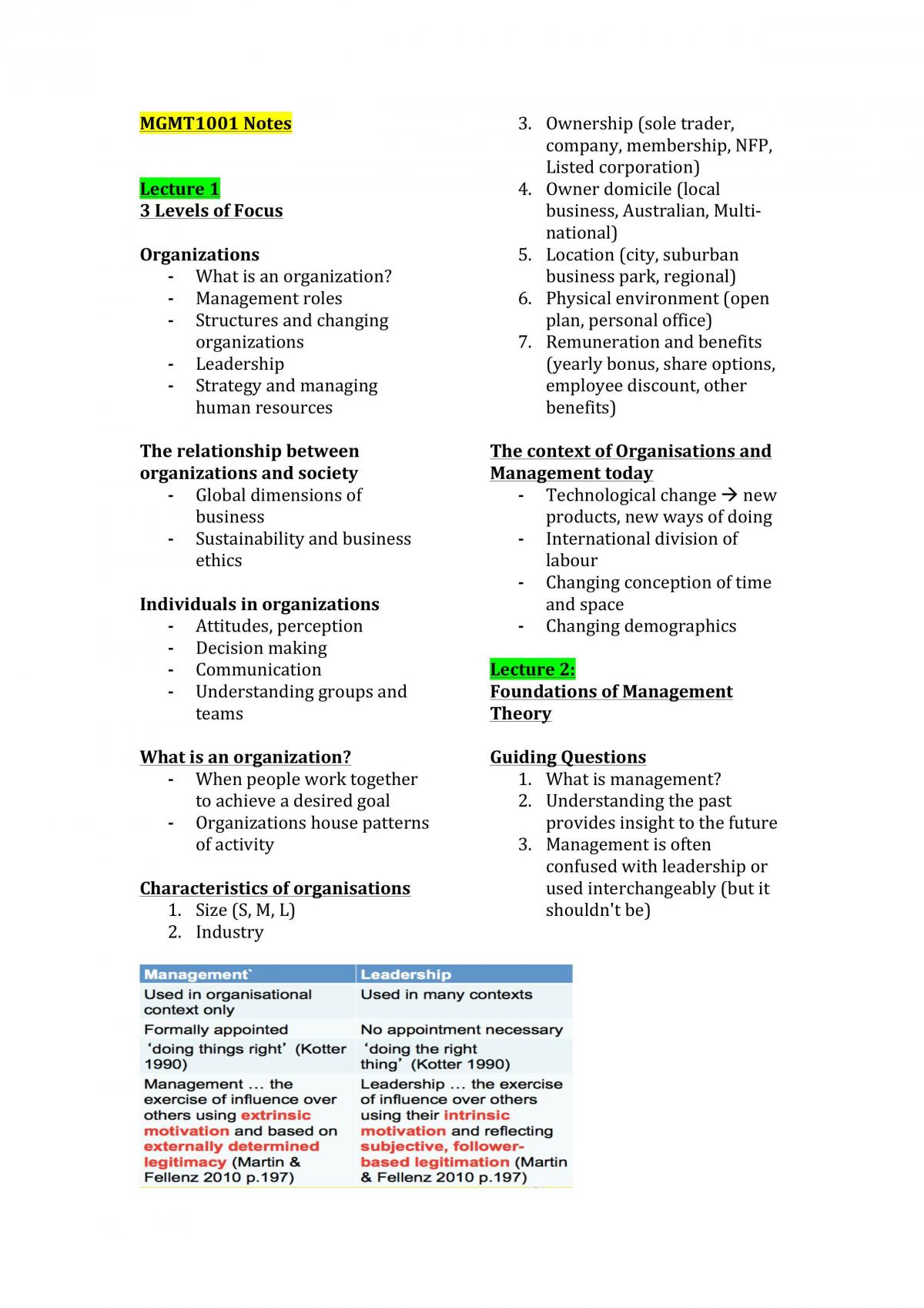Find
Search for over 200,000 study notes and past assignments!
Swap
Download study resources by swapping your own or buying Exchange Credits.
Study
Study from your library anywhere, anytime.
MGMT1001 Full Course Summary
MGMT1001 - Managing Organisations and People
30 Pages • Complete Study Notes • Year: Pre-2021
Lecture 1 3 Levels of Focus Organizations - What is an organization? - Management roles - Structures and changing organizations - Leadership - Strategy and managing human resources The relationship between organizations and society - Global dimensions of business - Sustainability and business ethics Individuals in organizations - Attitudes, perception - Decision making - Communication - Understanding groups and teams What is an organization? - When people work together to achieve a desired goal - Organizations house patterns of activity Characteristics of organisations 1. Size (S, M, L) 2. Industry 3. Ownership (sole trader, company, membership, NFP, Listed corporation) 4. Owner domicile (local business, Australian, Multi- national) 5. Location (city, suburban business park, regional) 6. Physical environment (open plan, personal office) 7. Remuneration and benefits (yearly bonus, share options, employee discount, other benefits) The context of Organisations and Management today - Technological change à new products, new ways of doing - International division of labour - Changing conception of time and space - Changing demographics Lecture 2: Foundations of Management Theory Guiding Questions 1. What is management? 2. Understanding the past provides insight to the future 3. Management is often confused with leadership or used interchangeably (but it shouldn't be)   Levels of Management Top Managers Middle Managers ‘First line’ Managers The Scientific- Technical Revolution and its effects on organisations and management Rise of factory system of production - Growth in number of employees - Increasing use of technology in production - Rise of ‘corporations’ meaning owners did not necessarily work in the organization Key features/developments - Specialisation of labour and the ‘production line’ - Systematic study of work tasks to create rules or ‘one best way’ of performing each task - Focus on both job design and organizational structures and administration Scientific approaches to management – Job Design Frederick W. Taylor (1856-1915) Four principles of ‘Scientific Management’ 1. Develop a science for each element of the job to replace the old ‘rule of thumb’ method 2. Managers should scientifically select and then train, teach and develop workers 3. 4. Managers should actively cooperate with the workers to ensure all work is being done in accordance to principles of the science developed An almost equal division of the work and responsibility should be between management and workers
This document is 25 Exchange Credits
More about this document:
|
|
This document has been hand checkedEvery document on Thinkswap has been carefully hand checked to make sure it's correctly described and categorised. No more browsing through piles of irrelevant study resources. |
|
|
This is a Complete Set of Study NotesComplete Study Notes typically cover at least half a semester’s content or several topics in greater depth. They are typically greater than 20 pages in length and go into more detail when covering topics. |
|
|
What are Exchange Credits?Exchange Credits represent the worth of each document on Thinkswap. In exchange for uploading documents you will receive Exchange Credits. These credits can then be used to download other documents for free. |
|
|
Satisfaction GuaranteeWe want you to be satisfied with your learning, that’s why all documents on Thinkswap are covered by our Satisfaction Guarantee. If a document is not of an acceptable quality or the document was incorrectly described or categorised, we will provide a full refund of Exchange Credits so that you can get another document. For more information please read Thinkswap's Satisfaction Guarantee. |

Studying with Academic Integrity
Studying from past student work is an amazing way to learn and research, however you must always act with academic integrity.
This document is the prior work of another student. Thinkswap has partnered with Turnitin to ensure students cannot copy directly from our resources. Understand how to responsibly use this work by visiting ‘Using Thinkswap resources correctly’.
Browse UNSW Subjects




